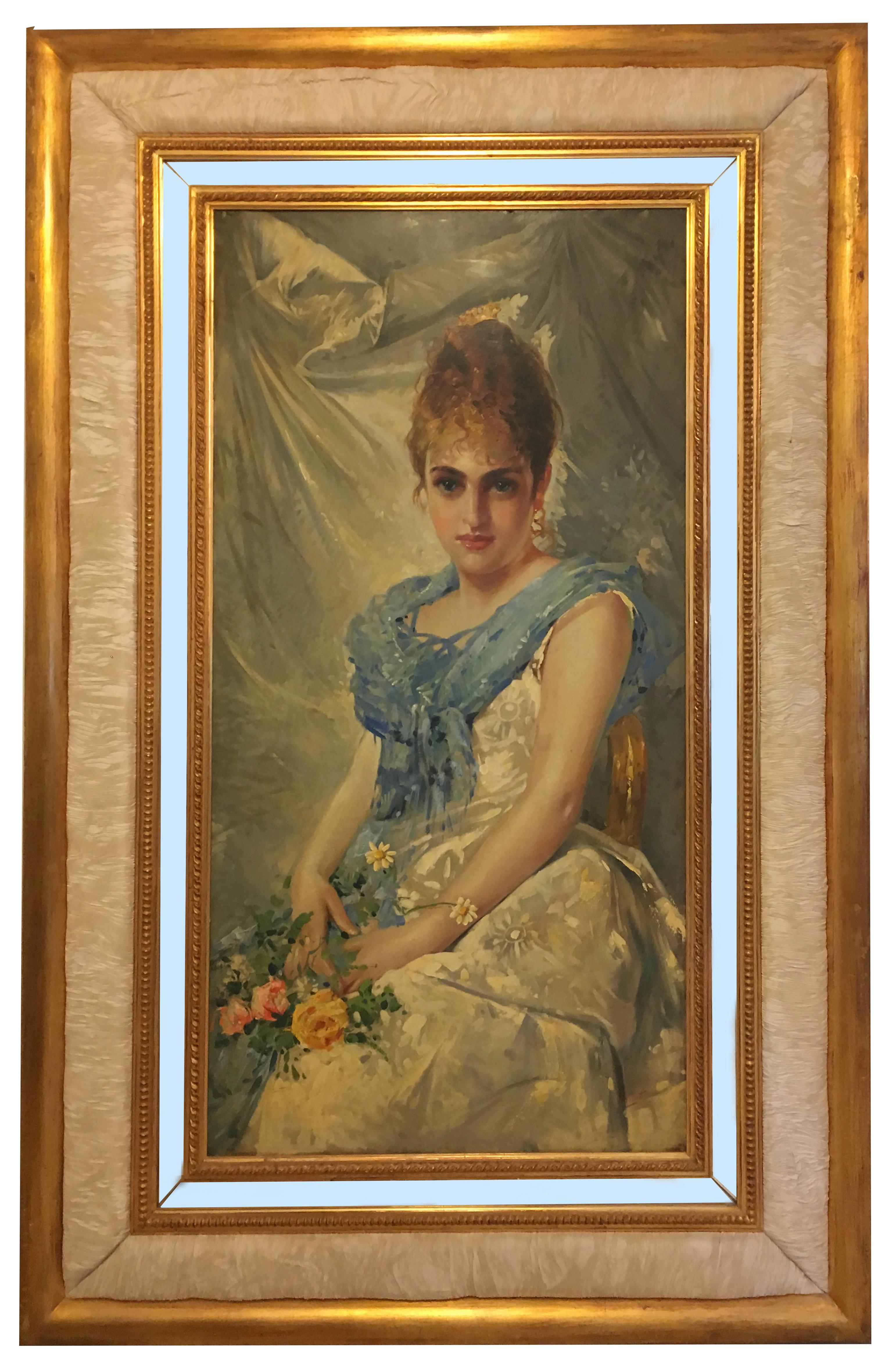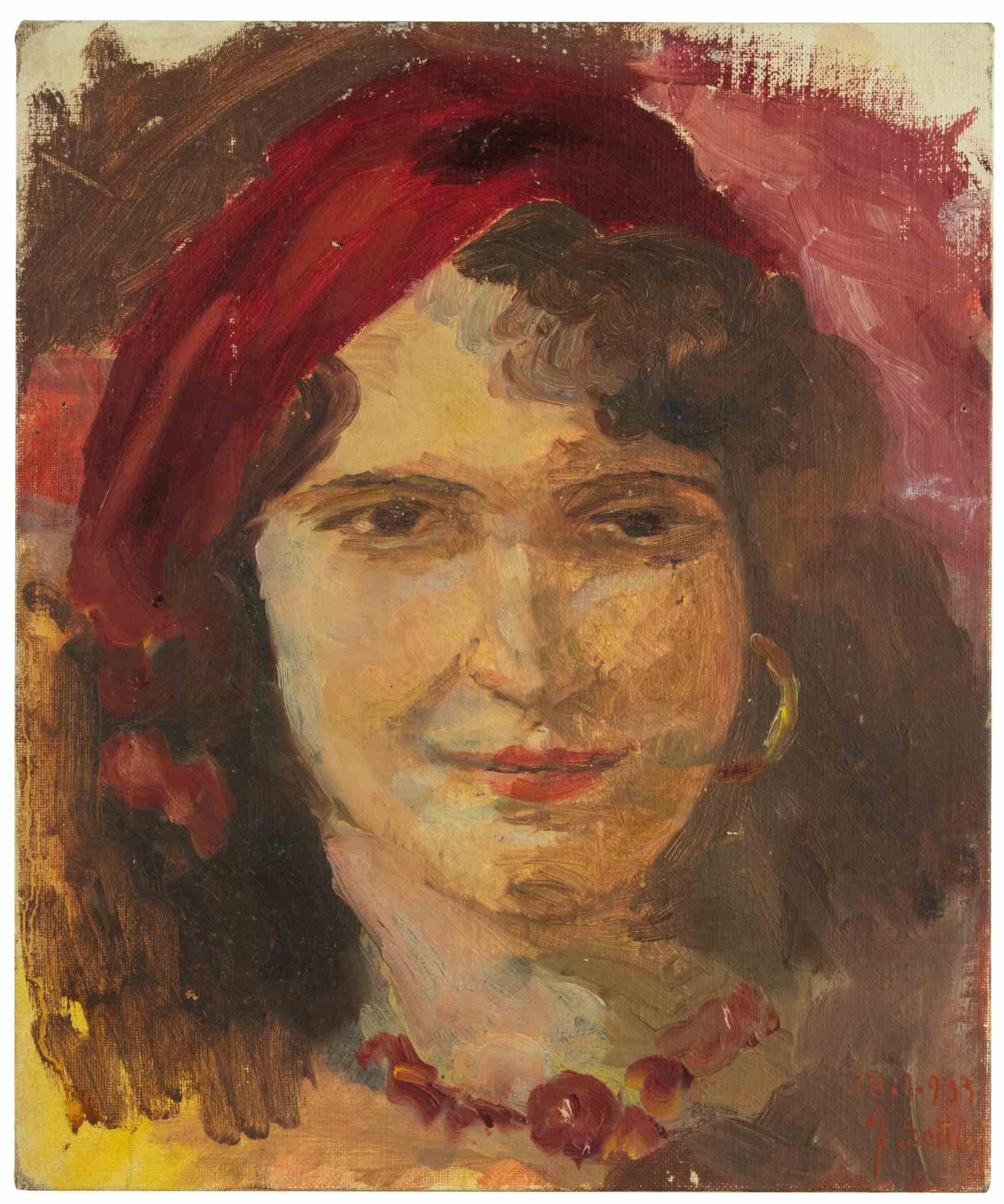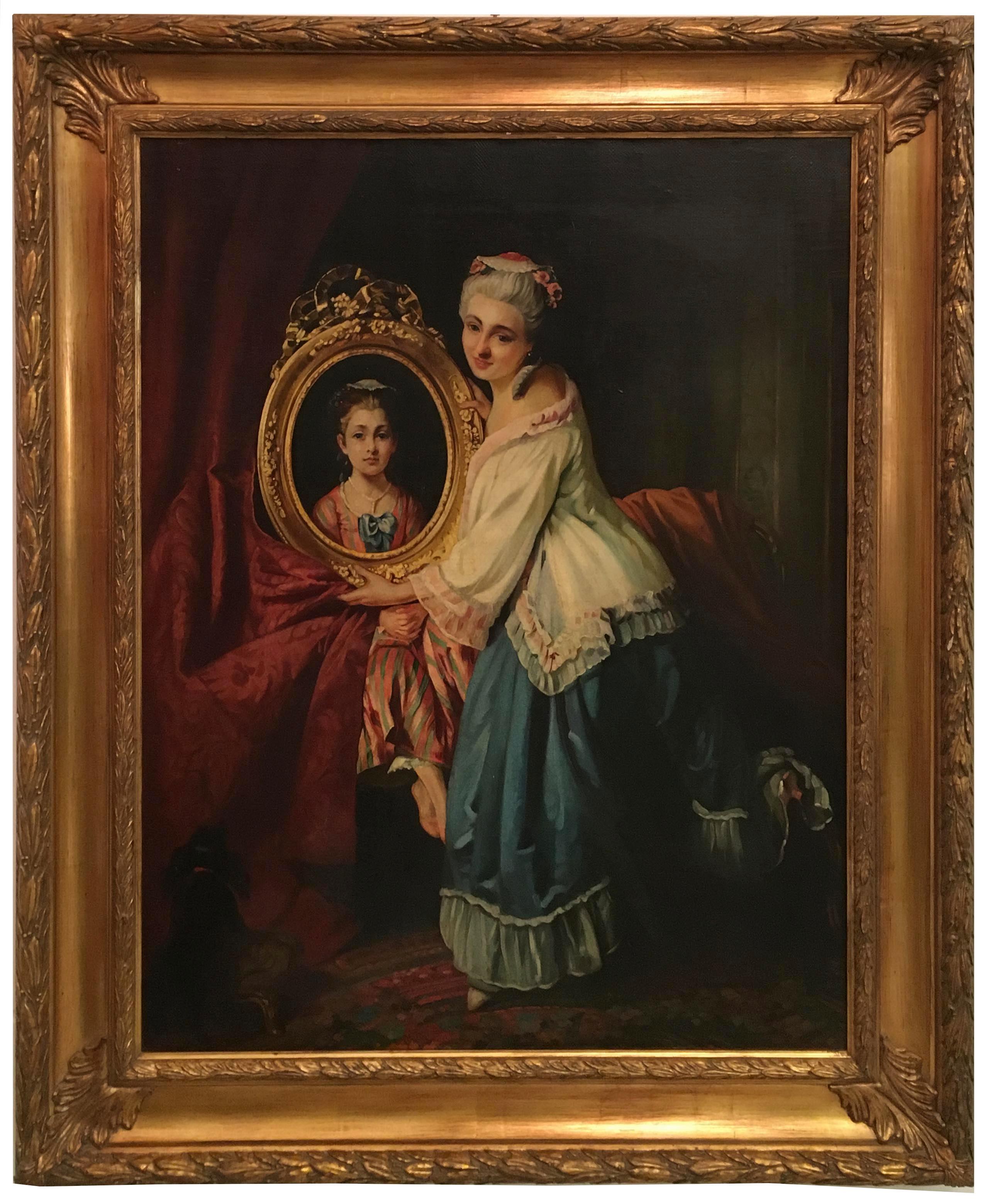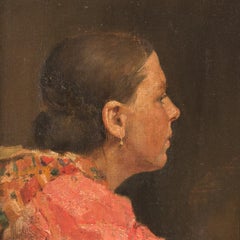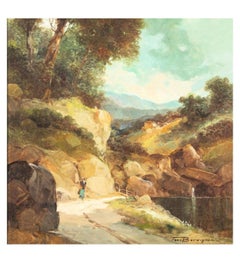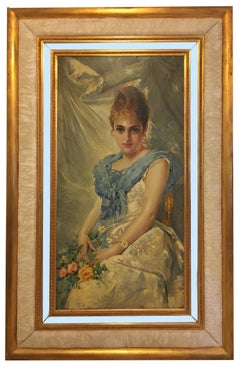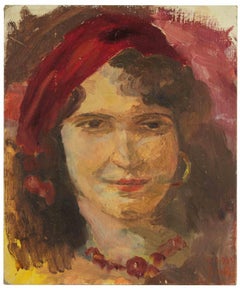Items Similar to The Beauty of Becoming Oil on canvas by Francesco Longo Mancini
Want more images or videos?
Request additional images or videos from the seller
1 of 12
Francesco Longo ManciniThe Beauty of Becoming Oil on canvas by Francesco Longo Mancini1920
1920
$22,964.54
£16,975.80
€19,250
CA$31,853.01
A$34,726.74
CHF 18,348.94
MX$427,057.22
NOK 228,154.30
SEK 214,777.04
DKK 146,578.85
About the Item
She sits at the threshold of transformation.
A young woman, caught in the quiet exultation before her first ball, smiles—not to anyone in particular, but to herself, and to the moment. The air around her hums with expectation. She has found the dress—the one that fits not only her figure but her sense of self, and in it, she knows she will shine. Not later, not when the music begins, but now, already, in this pause before the event. She is radiant, not yet dancing, but already arrived.
Her face is the heart of the painting: fully formed, glowing with life, finished with the kind of intimate precision that makes us feel as if we are meeting a real person. Her expression, suspended between confidence and joy, draws us in. But then, the world around her begins to shift. From that central gaze, the image seems to expand outward—into suggestion, movement, light.
Her dress is not so much painted as sculpted onto the canvas: its folds rise and flutter from bold, instinctive brushstrokes that seem to have grown directly from the raw linen. Background and gown blur together, created from the same gestures, the same energy. It’s as if the painter has let go of representation, allowing feeling to shape form.
And in this interplay of precision and abandon, of portrait and atmosphere, Mancini captures more than a sitter. He captures a mood, a stage of life, a private electricity we all recognize—the moment just before becoming. The beauty is not in the dress, nor even in the smile, but in that rare convergence of anticipation and self-possession. A quiet revelation.
This is not a temporary scene; it is a timeless one. The girl’s joy may be personal, but it is also universal. Her transformation is not hers alone. It is ours.
This is the beauty of becoming.
There are echoes, too, of other great portraitists of transformation. Like John Singer Sargent, Mancini understands how light plays on skin and silk, how a single glance can suggest a world of inner thought. But while Sargent often composed with elegance and cool distance, Mancini brings us closer—his warmth more intimate, his brush looser, more instinctive. And there is something of Giovanni Boldini in the sweeping energy of the gown, in the painterly calligraphy that flutters across the canvas. Yet where Boldini dazzles with motion and society’s glitter, Mancini remains rooted in something quieter, more interior. His subject is not spectacle, but emergence—the quiet poetry of a girl who has not yet stepped into the ballroom, but who already knows she will own it.
- Creator:Francesco Longo Mancini (1880 - 1954)
- Creation Year:1920
- Dimensions:Height: 45.67 in (116 cm)Width: 40.56 in (103 cm)Depth: 1.97 in (5 cm)
- Medium:
- Movement & Style:
- Period:
- Condition:
- Gallery Location:Gent, BE
- Reference Number:1stDibs: LU2140216360532
About the Seller
5.0
Vetted Professional Seller
Every seller passes strict standards for authenticity and reliability
Established in 2018
1stDibs seller since 2022
5 sales on 1stDibs
Typical response time: 2 hours
- ShippingRetrieving quote...Shipping from: Gent, Belgium
- Return Policy
Authenticity Guarantee
In the unlikely event there’s an issue with an item’s authenticity, contact us within 1 year for a full refund. DetailsMoney-Back Guarantee
If your item is not as described, is damaged in transit, or does not arrive, contact us within 7 days for a full refund. Details24-Hour Cancellation
You have a 24-hour grace period in which to reconsider your purchase, with no questions asked.Vetted Professional Sellers
Our world-class sellers must adhere to strict standards for service and quality, maintaining the integrity of our listings.Price-Match Guarantee
If you find that a seller listed the same item for a lower price elsewhere, we’ll match it.Trusted Global Delivery
Our best-in-class carrier network provides specialized shipping options worldwide, including custom delivery.More From This Seller
View AllDemetrio COSOLA (1851 – 1895) Portrait of a woman Oil on canvas
Located in Gent, VOV
Cosola Demetrio (1851-1895)
Demetrio Cosola lived his entire short life between Chivasso and Turin. At the age of eighteen he entered the Accademia Albertina in Turin, where he becam...
Category
19th Century Portrait Paintings
Materials
Canvas, Oil
Charles Louis Verwee (1832-1882) A Possible Purchase
Located in Gent, VOV
The painting "A Possible Purchase" by Charles Louis Verwee, a renowned Belgian artist, captures a delicate and poignant moment. In this piece, a woman is depicted standing in an opul...
Category
19th Century Figurative Paintings
Materials
Oil
TONI BORDIGNON, in the Old Master style, Capriccio landscape painting
Located in Gent, VOV
A twentieth-century Italian landscape painting in the convincing style of the Old Masters, framed, an impressive 91 x 60 cm (with frame 121 * !à cm), signed lower left by TONI BORDIG...
Category
20th Century Old Masters Landscape Paintings
Materials
Oil
Léon BRUNIN (1861 - 1949)+Oil on panel, Art collectors
Located in Gent, VOV
Les collectionneurs d'art, Oil on panel by Léon BRUNIN (1861 - 1949)
Léon Brunin's subjects are always meticulously painted, with abundant reproduction of detail and as many shades ...
Category
Late 19th Century Realist Figurative Paintings
Materials
Oil
Christian Valdemar Clausen+ Oil on canvas Interior
By Christian Valdemar Clausen
Located in Gent, VOV
The painting by Christian Valdemar Clausen of an intimate and cozy interior scene, likely depicting a well-furnished sitting room or parlor.
Christian Valdemar Clausen was known for...
Category
19th Century Realist Interior Paintings
Materials
Oil
Impressionism painting 4 Oil on panel by Pierre Vlerick (1923 - 1999)
Located in Gent, VOV
This painting is a perfect example of lyrical abstraction and a choice painting out of the best period of Vlerick's career.
Pierre Vlerick’s work shows...
Category
1960s Abstract Impressionist Abstract Paintings
Materials
Masonite, Oil
You May Also Like
SPRING BEAUTY - Angelo Granati - Oirtrair of Oil on Canvas Painting
By Angelo Granati
Located in Napoli, IT
SPRING BEAUTY - Oil on canvas painting by Angelo Granati, Italy 2011
Gold leaf gilded, pleated silk and mirror wooden frame ext. mis. cm. 164x106.
This is his reinterpretation of pa...
Category
2010s French School Figurative Paintings
Materials
Canvas, Oil
PORTRAIT- Angelo Granati -Figurative Oil on panel painting
By Angelo Granati
Located in Napoli, IT
Portarit - Angelo Granati Italia 2019 - Oil on panel cm.70 x 50.
This is his reinterpretation of a greatest old master painting "Portrait de la duchesse de Morny, née princesse Troubetzko "by Franz Xaver Winterhalteri.
Franz Xaver Winterhalter was a German painter and lithographer.
He worked in numerous European courts, such as Karlsruhe, Paris, London, Prague and Moscow, performing grandiose portraits of rulers, such as the one for King Louis Philippe of France in 1839 (in Versailles) or the one for Queen Victoria with her family in 1842 at Windsor Castle.
He also painted three famous portraits of Empress Elisabeth of Austria...
Category
2010s Italian School Interior Paintings
Materials
Oil, Wood Panel
Portrait - Painting by Francesco Settimj - 1933
Located in Roma, IT
Oil on canvas applied on cardboard realized by Francesco Settimj in 1933.
Hand signed and dated lower right.
Good condition except for some very inor losses on edges.
Category
1930s Modern Figurative Paintings
Materials
Oil
PORTRAIT OF YOUNG WOMAN - Neapolitan School - Italian Oil On Canvas Painting
By Ciro De Lucia
Located in Napoli, IT
Portrait of Young woman - Ciro De Lucia Italia 2002 - Oil on canvas cm. 50x40.
The painting by the painter Ciro De Lucia depicts a portrait of a young woman of the people, he is inspired by Neapolitan painting...
Category
Early 2000s Italian School Portrait Paintings
Materials
Canvas, Oil
Portrait of Carlotta Parisani
Located in Roma, RM
Napoleone Parisani (Camerino 1853 - Rome 1932), Portrait of Carlotta Parisani
Oil on canvas 35 x 24 cm with monogram at lower left and lower right, on back: inscribed "A M.r and M.m...
Category
Late 19th Century Other Art Style Portrait Paintings
Materials
Canvas, Oil
THE BEATIFUL FRAME - Angelo Granati - Figurative oil on canvas painting
By Angelo Granati
Located in Napoli, IT
THE BEAUTIFUL FRAME - Angelo Granati Italia 2003
Oil on canvas cm.90x70.
Gold leaf gilded wooden frame mis. ext.110X90
In this painting, Maestro Angelo Granati drew inspiration from the paintings of the French school.
Mom and daughter...
Category
Early 2000s French School Figurative Paintings
Materials
Canvas, Oil
More Ways To Browse
Francesco Mancini
Spanish Jewish
Terry Shelbourne
Tiziano Vecellio
16th Century Religious Painting
1860 Oil Painting Of Woman In Black Dress
Antique Oil Painting Skull
Antique Oil Portrait Child
Bernardino Campi
Consuelo Vanderbilt
David Alison
Dod Procter
Elizabethan Dress
Elizabethan Painting
Erik Olson
Francois De Troy
George Knapton
Hibel Oil
